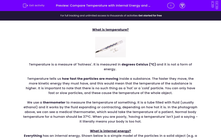What is temperature?

Temperature is a measure of 'hotness'. It is measured in degrees Celsius (ºC) and it is not a form of energy.
Temperature tells us how fast the particles are moving inside a substance. The faster they move, the more kinetic energy they must have, and this would mean that the temperature of the substance is higher. It is important to note that there is no such thing as a 'hot' or a 'cold' particle. You can only have fast or slow particles, and these cause the temperature of the whole object.
We use a thermometer to measure the temperature of something. It is a tube filled with fluid (usually ethanol) and it works by the fluid expanding or contracting, depending on how hot it is. In the photograph above, we can see a medical thermometer, which would take the temperature of a patient. Normal body temperature for a human should be 37ºC. When you are poorly, 'having a temperature' isn't just a saying - it literally means your body is too hot.
What is internal energy?
Everything has an internal energy. Shown below is a simple model of the particles in a solid object (e.g. a lump of coal).
These particles have kinetic energy, due to their movement. Remember, even particles in a solid are constantly vibrating about a fixed position. They also have potential energy, due to their positions. If you added up all of the kinetic energies and potential energies of every particle inside an object, you would have its internal energy. This is measured in Joules (J).
For an object to have a large amount of internal energy, it would either have faster-moving particles (caused by a high temperature), or just contain a very high number of particles (caused by having a large mass). You can think of the internal energy of an object as the energy 'stored' inside it, due to its temperature. Note: this is not the same as 'heat'.
What is thermal energy?

We still haven't defined this word 'heat' yet! If it isn't temperature, and it isn't the energy stored inside an object due to its temperature, then what is it?
When internal energy is transferred from a hot object to a cold object (or its surroundings), we refer to it as thermal energy. This is the definition of heat. For, example, if the lump of coal is on an open fire, it will crumble away and decrease its temperature, therefore losing internal energy as it heats the air around it.
Heat - being thermal energy - is also measured in Joules (J). It is harder to calculate the heat energy transferred by an object, compared to measuring its temperature. You would need measurements of temperature and mass, and you would also need to do some calculations using properties of the material you were testing, along with the power of the supply and the time taken to raise its temperature. The process of calculating energy transferred by heat is called calorimetry.
Let's try some questions on this. Don't worry if this seems a bit confusing, you can come back to this page by clicking on the red help button on the screen at any point.









